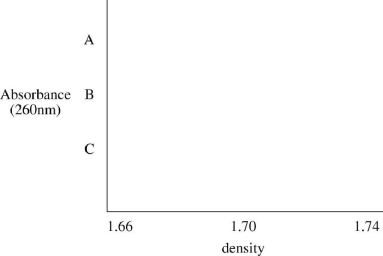Assume that you grew a culture of E. coli for many generations in medium containing 15N (from the ammonium ion), a heavy isotope of nitrogen. You extract DNA from a portion of the culture and determine its density to be 1.723 gm/cm3 (call this sample
A). You then wash the remaining E. coli cells and grow them for one generation in 14N, extract the DNA from a portion of the culture, and determine its density to be 1.715 gm/cm3 (call this sample
B). You let the culture grow for one more generation in 14N, and extract the DNA (call this sample
C) is then heated to completely denature the double-stranded structures, cooled quickly (to keep the strands separate), and subjected to ultracentrifugation. Present the centrifugation profiles for heat-denatured DNA (samples A, B, and
C) that you would expect. Use the graph below. (Note: Although not the case, assume that single-stranded DNA has the same density as double-stranded DNA.)

C). Each sample of DNA (A, B, and
Definitions:
Burnout
A state of physical, emotional, and mental exhaustion caused by prolonged stress, often related to work.
Dysphoria
A profound state of unease or dissatisfaction, often accompanied by depression, anxiety, or agitation.
Epidemiology
The study and analysis of the distribution, patterns, and determinants of health and disease conditions in defined populations.
Task Variety
The degree to which a job or role involves a variety of different activities requiring different skills and talents, contributing to job satisfaction and motivation.
Q1: A missense mutation causes premature chain (protein)
Q3: Describe the positive control exerted by the
Q4: What is meant by the term pseudogene?
Q9: Electron microscopy of metaphase chromosomes demonstrated various
Q9: Which phenotypic ratio is likely to occur
Q12: Transcription in eukaryotes is generally influenced by
Q15: A color-blind woman with Turner syndrome (XO)
Q21: Transduction is a form of recombination in
Q27: Caenorhabditis elegans is extremely useful as an
Q31: In humans, the male is the homogametic